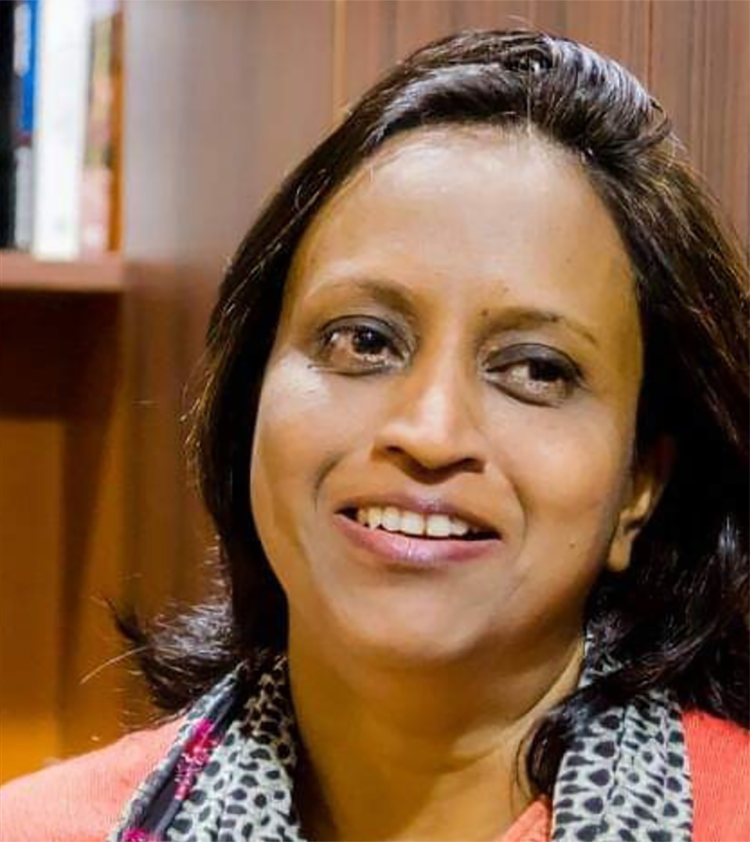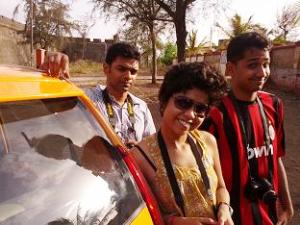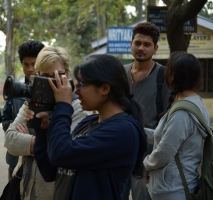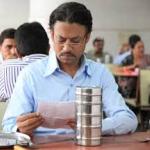The city I live in is water to the fish, air to the birds: it passes unnoticed. As a writer, one responds to minute changes and to tectonic, seismic shifts in its interior geography. At the level of the trivial, the cutting of a tree that was in one's line of vision becomes a major event, the closing of a grocery shop to make way for another ATM is significant. On the larger level, it is the political and the economic changes that make Mumbai such a significant place. Here everything is in flux and this instability, this constant change makes people fearful and anxious. This free-floating anxiety is what right-wing and parochial forces feed on. The greatest shifts in Mumbai's destiny have happened as I have grown up in this city: the mill strike called by Datta Samant, the collapse of Mumbai as a productive economy and its transformation into a speculative economy, the growth of the suburbs and the stresses of four-hour commutes in sub-human conditions, the increasing intolerance, the communal tensions of 1992 and 1993, the bomb blasts that followed and the terrorist attacks.
If anyone from a small town craves a passage to Mumbai, I would say, "Please come, we need your energy and your resources, your intensity and your abilities. But we will exploit these ruthlessly and we might turn on you suddenly because we are now as insular as we are expansive, as mean-minded as we are hospitable. And finally, despite its relentless pace, despite its terrible living conditions, despite everything, Mumbai might become an addiction which you might never be able to shake off."
I began writing this book 20 years, maybe more than that. I wrote 27 drafts of it and sometimes I think there have been 27 drafts of the city outside the balcony. This is the way it must be. A city that remains unchanged over 20 years must be in the state that Pompeii is: petrified, dead, everything frozen in time. Much of the change has, as anyone knows, been for the worse. We live and love on a tinderbox; at any time, some tectonic plate will shift and we will all be crushed. You would not wish that on an enemy but for a writer, it is a source of unending inspiration, of magnificent material.
Has your journalism ever tried to delve into the lives of people in other parts of India, for instance the Northeast of India?
I believe that we all have a duty to tell each other stories. Journalists therefore have a special and unique responsibility in a country like ours. We are the bridges on which cultures must cross and each story we tell makes the bridge stronger. But I also believe that we have a duty to the story inside, the one we want to tell. I have heard thousands of people say, "If only I could find the time to sit down and write, I would be able to turn out a magnificent book." And I smile and think, "Yes, if only." Because we have enough books. Every reader has a wish list and a guilt list. The wish list comprises the book she wants to read. The guilt list comprises the books she knows she ought to read. And then there is the book she is reading which does not belong on either. So no one needs another book. Why do we keep writing? Because we, those who write, need to write. The question is: do you need to write enough to find the time to write that book? And make no mistake you don't just write a book, you craft a self. And in that process something shifts and changes. Each time.
So it is up to the Northeast to tell the stories of the Northeast. It is up to a young Manipuri boy to sit down and start work on a story, knowing that it may take him twenty years to get to the place where he might find a publisher, but to push on all the same. It is up to a young Naga woman to sit down with her grandmother and tell her story. It is up to some Arunachali pensioner to pick up his pen and start work on the magnum opus he had dreamed of writing. And so on for all the other states. Then come other battles. Who will publish these books? Who will translate them if they are written in the bhashas (languages) of the states? Who will read them? There are no easy answers but the questions don't have to be asked when the books haven't been written.
What or who inspired you to write?
I did not think, when I was growing up, that I would be ever able to write or that I would ever be a journalist. This was because of some failure of the educational system, I believe. No one ever encourages a child who shows some talent at language by asking, "Have you ever thought of becoming a writer?" (This seems to have changed. One of my friends, Paritosh Palkhivala, is sixteen and knows what he wants to do; he is going to be a writer of thrillers. I think that's very cool.)
I began only because I was lucky enough to have a good friend who kept urging and encouraging me to write. I was at the time making a living on teaching mathematics privately. And my friend, Rashmi Palkhivala, would keep saying I should write for the papers, I should write funnies. I said, only half-joking, that my ego would not take rejection. So she said, "You write them, I'll type them and take them to the editors. You won't have to know whether they reject you or not." In the next week, fourteen pieces came pouring out of me. She typed them up and took them to Mid-Day. They accepted twelve. I was over the moon but within twenty seconds, I was asking: "Which were the two they didn't like? And why didn't they like them?" The Buddha was right; there is no end to desire.
But here I must also add that I did not think, when I was a journalist, that I would ever be able to write a book. And then I had the great good luck to get Ravi Singh as an editor and publisher. Someone has to give you courage, someone has to stand behind you and root for you, someone has to say, "I think you can do this if you try." Unfortunately, our world seems to consist of people who say, "Do you really think you should be trying to do that?" and other such comments.
Please tell us about your stint as a Mathematics tutor. Did you find mathematics interesting? Usually writers seem to abhor Mathematics.
I began to work because I needed money to buy books. My father did not think anyone under the age of 21 should buy books. This was because he believed that you would waste your money on books you would not want to keep. And so he felt that young people and adolescents should use libraries and read as much as they could but not buy books. This was good advice, of course, but both my sister Andrea and I, were already avid book collectors by the time we were in double figures. So when I was sixteen, I began to teach privately. I taught mathematics because I loved it in school after a particularly inspiring teacher, Mrs Lidwin D'Souza, explained how it was a language, an esoteric beautiful language, but a language nonetheless. I decided I would try and teach it as a language, interspersing quadratic equations with van Gogh, teaching trigonometry and Lewis Carroll. And then when I was 22 years old, I started writing for the papers. For the next eight years, I balanced a freelance journalism career with private tuitions in mathematics. I made great friends in both places.
Please tell us about your experiences in writing the book The Life and Times of an H-Bomb. How did you come to write this book on Helen? Were you a big fan?
The Life and Times of an H-Bomb began when Ravi Singh, who was then with Penguin and who is now with Aleph, asked, "Who do you think should write a book on Helen?" (I remember where we were sitting - in the basement bar at the Gordon Hotel in Mumbai and the blue glass ashtrays on the table quite clearly.) "Me," I said and that was it. I began the next day by going to a video store in Lamington Road, then Mumbai's Cinema Street, to buy some films in which she had starred. I was determined to see all her films because I have always believed that most books on Indian film stars are lazy works; the writer sees the main films or what he considers the important films and ignores everything else. This is ridiculous because most film stars have done about a hundred films in their lifetimes. And here I was setting out to work on Helen who said that she had worked on anything between 700 to a thousand films in several languages, including Bhojpuri, Marathi, Tamil and Telugu. I had no idea how it could be done but I was going to do it. I spent the next two years watching films and making notes, working on the ideas that I wanted to express. Because that is the other problem with the way in which most books about Hindi film stars are written. They are hagiographical accounts without anything to say about the social contexts, the historic moment, the consumption of cinema. I wanted my book to be different.
And finally, I do not believe there has ever been, anywhere in the world, a phenomenon like Helen Khan nee Richardson. She was unique. In every cinema, women age faster than men. Take a look at Raakhee who was Amitabh Bachchan's bhabhi in Reshma aur Shera, his beloved in Muqaddar ka Sikandar, his mother in Shakti. He was still a hero. And female dancers age faster than female stars. Consider where Raakhee Sawant is today. Now look at Helen's career graph. She vamped her way through three generations of stars: she vamped Prithviraj Kapoor in Harishchandra Taramati; she vamped Raj Kapoor in Anari; she vamped Rishi Kapoor in Phool Khile Hain Gulshan Gulshan. If there had not been a Helen, Bollywood would have had to invent her.
How do you manage to step into dual worlds - a world of hard facts as a journalist and a realm of fiction as a writer? Do you lead a dual life?
Is there anyone who has a single life? I can't think of a single one of my friends who defines himself in a single unitary way all the time. In fact, I believe if you look at the life of the average working woman, you will see her shapeshift her way through the day: from lover to mother to banker to daughter and back and around, back and around all through the day. The definitions are generally conveniences; the world wants to see me as a journalist; I want to see myself as a writer today. Tomorrow, I may change my self-definition. The world will be slower to follow but that is the fate of anyone who wants to say, like Walt Whitman, "I contain multitudes".
Your first book Surviving Women was a manual on gender politics and you had edited the Man's World. Do you think women are getting disproportionate interest and space in the media and other spheres of life? Do you think there are less of efforts to understand the mind of an ordinary man?
I think we have a long way to go before we can say that women are getting disproportionate interest. They represent half the sky; and they don't get even a hundredth of the media attention that men get. Take cricket for instance. It is a male-dominated sport and a national obsession. But no one seems to know who the captain of the Indian women's cricket team is. Take the money paid to Aishwarya Rai and the money paid to Akshay Kumar and you will see the difference. Take a headcount of CEOs and the figures will startle you. Gender equality is a dream and all these stories, these "you've-come-a-long-way" stories, these don't reflect ground realities. Reality is female foeticide. Reality is leaving a girl child to die in the sun. Reality is dowry death. Reality is honour killings. Reality is rape.
At the same time, I don't think there is any attempt to understand the Indian man and why he is the way he is. I don't think we have seriously addressed gender in India. Most of our ways of seeing are borrowed and that's always going to be problematic.
Jerry Pinto is also a poet.
Indeed. It is not an easy thing to be a poet in India. Publishers keep asking: who reads poetry these days? To which the answer is: who reads anything these days? And since no one is reading, let's just shut shop and go home and post our best ideas on social networking sites. No, say the publishers, people are reading. Well, then, there is a subset of those readers who would be interested in poetry. How shall they be served?
My second book of poems is nearly ready. I have a contract with a major corporation. I have no idea whether they will or will not honour that contract. But that's true of everyone from royalty to newcomers, no one has a publisher, no one has the assurance of a publisher waiting for the next manuscript. So what makes the next poem come? It is the pressure of its wanting to be born, its insistence. You can only want to make poetry happen and that is why it happens.
Now, you are also into media education. There has been a mushroom growth of media schools all over the country, some even offering crash courses. How do you see this new trend? What do you think is missing from the classrooms of these media schools?
Twelve years ago Jeroo Mulla invited me to take journalism practicals at Social Communications Media, Sophia Polytechnic. I was honoured and a bit apprehensive because I had never been to any media school myself. So I asked my friends who had studied abroad what had worked for them and what hadn't. I asked them to tell me what they remembered and I put in my own experiences and devised a method by which I felt journalism could be turned into something they did rather than something they heard about.
I believe that most urban middle-class Indian students do not make engage with their cities in a robust manner. They see their cities from behind the frosted glass of their parents' cars. The city is mapped for them by their parents' expectations. They consume the city rather than experience it. It is this that my class seeks to change. Each student is assigned a beat area in a far-flung suburb of this monstrous urban conurbation we call Mumbai. Each student is expected to submit a series of stories from the beat area covering a range of topics that will challenge them to learn how to access information, meet a range of people, and understand their problems. I believe that this is important in developing a real connection with the city. Through the course of the year, I set them a series of tasks of increasing difficulty levels. I challenge them to read. I force them to write more than they have ever written before in their lives. One of the most important of these assignments is when each student must turn in a 5000-word essay on her mother. In that week, I read 200,000 words and edit them; this is the equivalent of reading War and Peace with critical attention. I mention this because this is what I believe is missing from most media classrooms and especially the newly-hatched courses, many of which seem to be a way to make a fast buck. I believe you can only teach when you agree to bear the burden of correction, of a genuine interaction with each student. Of course, this also means that the students must be willing to put in their energy and their commitment; you cannot get more out of a system than you put into it. This is as much a law of human nature as it is of thermodynamics.
You are part of the child rights organization Mel Jol? How did you develop interest in this issue? Please tell us about your experiences?
I am cannibalising here an essay I wrote for Mint Lounge. I read about Childline in a newspaper called The Metropolis on Saturday in 1996. I thought it was a good idea: street children attending to a helpline for children in distress. I called the number, wrote a cheque and forgot about it.
But a week later, three social workers came looking for me. That was the whole Childline team then: Jeroo Billimoria, who had invented it; Prakash Fernandes, who drew the charts and did the writing; and Meghna Sawant, who did everything else. Billimoria wasted no time.
"We need your help," she said.
"I'd love to help but what can I do?" I asked.
"We are thinking about a training manual. You could edit that for us," Billimoria said.
That was more like it. Editing I could do. That was something I had done for years.
Over the next few weeks, I found that I had much to learn. The social development sector has its own locutions, its own formulations. But behind each clunky phrase is an idea. For instance, one does not "help" people understand child rights; one "orients" them towards child rights. This sounded silly when I was editing it. But later, it was explained to me. If you say "help", you are assuming that you are in a superior position of power. Help always flows downwards. If you say "orients", you are both on the same plane, you are offering a suggestion as equals.
To many this may sound like not calling a spade a spade. I don't think so. It's about caring enough to make sure you try and do what is needed, not ride in to reform everyone and show them how things should be done. Too often, volunteers assume that they bring sound common sense to the development sector. They do, but every volunteer would do well to remember that those who are professionally involved in development work have studied several models, tried various methods, and are standing on the shoulders of the giants of their field.
A little humility goes a long way.
I learnt this in one long and insight-packed night. After several weeks of email exchanges, Billimoria rang me up and suggested that we meet in the Childline office for half an hour so she could orient me to the needs of editing a manual in the development sector. At around 7pm, we sat down at a computer, I cracked my knuckles, she ordered tea and we began work. At 2am, the watchman of the building came in to complain. Billimoria emailed the file to herself and we went off in search of one of her friends who had a computer at home. At 3am, we were ensconced in front of a computer of some bemused friend who had opened her door, asked if we wanted some coffee, and then gone back to sleep without giving us any. At 5am, it was done and I had learnt that if you want to help, you have to relearn several things.
Over the course of the next five years, I edited eight or nine manuals for Childline. I did their reports, edited their proposals and then the inevitable happened. Childline became a government project. It had funds. It was in 50 cities. It was big and it would survive.
"I want you to help Meljol," said Billimoria in 2001.
I liked the idea. Meljol was a small struggling organization at the time. It had no funds though it was doing pioneering work in child rights. By the way, the term "child rights" does not mean children going on strike for their rights; it only means that children have the right to survival, to development, to protection and participation. In the face of every child labourer, in the body of every child sex worker, you can see a violation of the basic rights of the child. Meljol works with children in the school system, with teachers in schools, to strengthen the notion that children have rights.
If you think this is unimportant, consider this. Most teachers think of the good student as the student who listens to the voice of authority and obeys immediately, without asking questions. Every Indian child internalizes this; the good child is the obedient child. Without a tradition of asking questions, without a tradition of asking for facts, without a tradition of independent thinking, the same children can turn into the cannon fodder of fascists. Meljol believes that India will reap what she sows in these classrooms. Where democratic values, tolerance, and a respect for differences are sown, we will reap an inclusive India.
For some years, I worked with Meljol, doing precisely what I had done with Childline. And then one day, Billimoria blew into town again. We drove to a school in which the students greeted Sumitra Ashtikar, our executive director, with the kind of approval reserved for film stars. They roared the Meljol song and danced the Meljol dance, Sumitra leading with panache, and they almost made me cry. Then suddenly, Billimoria asked whether anyone had a bank account.
No one did. She asked who had been inside a bank. A very few had. She asked how many children had parents who had bank accounts. Not too many. Less than 40%.
On the way back, during the long drive from the outskirts of Panvel to the office of Meljol, located in a municipal school in Bombay Central, she outlined her plan. "A bank for children, no, we'll call it a child savings scheme, the word bank brings all kinds of problems with it. And we have to have a passbook. And maybe a bank day, on which deposits are made, and withdrawals. No, they can't just withdraw. They have to say why. It should be written in the book, put in another column, there. No, we should use the Meljol clubs for this. It should be one of their activities. Where should the money be kept? With the teacher. Later we can have them open accounts in the banks. Or the post offices. Even where there are no banks, there are post offices. We need to talk to the post offices..."
And so it went. By the time we were back in the city, Sumitra and I were exhausted but we knew that we had another project to start. Neither of us was sure it would work. But today hundreds of thousands of children are learning the concept of savings, not just in rural Maharashtra but in 20 countries all over the world. Meljol's concept lives and breathes in Egypt and Vietnam, in Brazil and Kenya, in Argentina and Serbia and is teaching children to take charge of their lives and their futures.
I know my role was small but it was one which gave me immense satisfaction of the kind you could experience tomorrow. You could be a lawyer or a doctor or a teacher or a homemaker. Your skills are needed. They can, with a little rejigging, be put to use. The social development sector needs corporate help more than ever before. It needs help with setting up systems, writing financial plans, corporate planning, things that will establish institutional longevity. As the global slowdown begins, it will have to turn self-sufficient. I still work pro bono with Meljol as executive secretary to the board of directors. More information can be found on www.meljol.net
How would you rate a good journalist? Do you think media today is obsessed with trivia?
I believe a good journalist should be a sceptic. She should be willing to take on authority. She should want to be the voice of the voiceless. She should believe in the power of words. She should know that the press has a huge commitment in India, a commitment to the millions of people who have no access to the corridors of power. I believe we are losing our readers because we are feeding them a diet of junk food. You can eat only so much junk food before your body rebels...or you die. We're in danger of killing of our readers with this overload of cricket, commerce and cinema.
" >
Mumbai has been a subject of films, songs and books. Almost everyone in a small town or city would crave to go to Mumbai. How was it like growing up in Mumbai in the 1960s and living in it now? What kind of changes have you seen in the city as a writer and a journalist?
The city I live in is water to the fish, air to the birds: it passes unnoticed. As a writer, one responds to minute changes and to tectonic, seismic shifts in its interior geography. At the level of the trivial, the cutting of a tree that was in one's line of vision becomes a major event, the closing of a grocery shop to make way for another ATM is significant. On the larger level, it is the political and the economic changes that make Mumbai such a significant place. Here everything is in flux and this instability, this constant change makes people fearful and anxious. This free-floating anxiety is what right-wing and parochial forces feed on. The greatest shifts in Mumbai's destiny have happened as I have grown up in this city: the mill strike called by Datta Samant, the collapse of Mumbai as a productive economy and its transformation into a speculative economy, the growth of the suburbs and the stresses of four-hour commutes in sub-human conditions, the increasing intolerance, the communal tensions of 1992 and 1993, the bomb blasts that followed and the terrorist attacks.
If anyone from a small town craves a passage to Mumbai, I would say, "Please come, we need your energy and your resources, your intensity and your abilities. But we will exploit these ruthlessly and we might turn on you suddenly because we are now as insular as we are expansive, as mean-minded as we are hospitable. And finally, despite its relentless pace, despite its terrible living conditions, despite everything, Mumbai might become an addiction which you might never be able to shake off."
I began writing this book 20 years, maybe more than that. I wrote 27 drafts of it and sometimes I think there have been 27 drafts of the city outside the balcony. This is the way it must be. A city that remains unchanged over 20 years must be in the state that Pompeii is: petrified, dead, everything frozen in time. Much of the change has, as anyone knows, been for the worse. We live and love on a tinderbox; at any time, some tectonic plate will shift and we will all be crushed. You would not wish that on an enemy but for a writer, it is a source of unending inspiration, of magnificent material.
Has your journalism ever tried to delve into the lives of people in other parts of India, for instance the Northeast of India?
I believe that we all have a duty to tell each other stories. Journalists therefore have a special and unique responsibility in a country like ours. We are the bridges on which cultures must cross and each story we tell makes the bridge stronger. But I also believe that we have a duty to the story inside, the one we want to tell. I have heard thousands of people say, "If only I could find the time to sit down and write, I would be able to turn out a magnificent book." And I smile and think, "Yes, if only." Because we have enough books. Every reader has a wish list and a guilt list. The wish list comprises the book she wants to read. The guilt list comprises the books she knows she ought to read. And then there is the book she is reading which does not belong on either. So no one needs another book. Why do we keep writing? Because we, those who write, need to write. The question is: do you need to write enough to find the time to write that book? And make no mistake you don't just write a book, you craft a self. And in that process something shifts and changes. Each time.
So it is up to the Northeast to tell the stories of the Northeast. It is up to a young Manipuri boy to sit down and start work on a story, knowing that it may take him twenty years to get to the place where he might find a publisher, but to push on all the same. It is up to a young Naga woman to sit down with her grandmother and tell her story. It is up to some Arunachali pensioner to pick up his pen and start work on the magnum opus he had dreamed of writing. And so on for all the other states. Then come other battles. Who will publish these books? Who will translate them if they are written in the bhashas (languages) of the states? Who will read them? There are no easy answers but the questions don't have to be asked when the books haven't been written.
What or who inspired you to write?
I did not think, when I was growing up, that I would be ever able to write or that I would ever be a journalist. This was because of some failure of the educational system, I believe. No one ever encourages a child who shows some talent at language by asking, "Have you ever thought of becoming a writer?" (This seems to have changed. One of my friends, Paritosh Palkhivala, is sixteen and knows what he wants to do; he is going to be a writer of thrillers. I think that's very cool.)
I began only because I was lucky enough to have a good friend who kept urging and encouraging me to write. I was at the time making a living on teaching mathematics privately. And my friend, Rashmi Palkhivala, would keep saying I should write for the papers, I should write funnies. I said, only half-joking, that my ego would not take rejection. So she said, "You write them, I'll type them and take them to the editors. You won't have to know whether they reject you or not." In the next week, fourteen pieces came pouring out of me. She typed them up and took them to Mid-Day. They accepted twelve. I was over the moon but within twenty seconds, I was asking: "Which were the two they didn't like? And why didn't they like them?" The Buddha was right; there is no end to desire.
But here I must also add that I did not think, when I was a journalist, that I would ever be able to write a book. And then I had the great good luck to get Ravi Singh as an editor and publisher. Someone has to give you courage, someone has to stand behind you and root for you, someone has to say, "I think you can do this if you try." Unfortunately, our world seems to consist of people who say, "Do you really think you should be trying to do that?" and other such comments.
Please tell us about your stint as a Mathematics tutor. Did you find mathematics interesting? Usually writers seem to abhor Mathematics.
I began to work because I needed money to buy books. My father did not think anyone under the age of 21 should buy books. This was because he believed that you would waste your money on books you would not want to keep. And so he felt that young people and adolescents should use libraries and read as much as they could but not buy books. This was good advice, of course, but both my sister Andrea and I, were already avid book collectors by the time we were in double figures. So when I was sixteen, I began to teach privately. I taught mathematics because I loved it in school after a particularly inspiring teacher, Mrs Lidwin D'Souza, explained how it was a language, an esoteric beautiful language, but a language nonetheless. I decided I would try and teach it as a language, interspersing quadratic equations with van Gogh, teaching trigonometry and Lewis Carroll. And then when I was 22 years old, I started writing for the papers. For the next eight years, I balanced a freelance journalism career with private tuitions in mathematics. I made great friends in both places.
Please tell us about your experiences in writing the book The Life and Times of an H-Bomb. How did you come to write this book on Helen? Were you a big fan?
The Life and Times of an H-Bomb began when Ravi Singh, who was then with Penguin and who is now with Aleph, asked, "Who do you think should write a book on Helen?" (I remember where we were sitting - in the basement bar at the Gordon Hotel in Mumbai and the blue glass ashtrays on the table quite clearly.) "Me," I said and that was it. I began the next day by going to a video store in Lamington Road, then Mumbai's Cinema Street, to buy some films in which she had starred. I was determined to see all her films because I have always believed that most books on Indian film stars are lazy works; the writer sees the main films or what he considers the important films and ignores everything else. This is ridiculous because most film stars have done about a hundred films in their lifetimes. And here I was setting out to work on Helen who said that she had worked on anything between 700 to a thousand films in several languages, including Bhojpuri, Marathi, Tamil and Telugu. I had no idea how it could be done but I was going to do it. I spent the next two years watching films and making notes, working on the ideas that I wanted to express. Because that is the other problem with the way in which most books about Hindi film stars are written. They are hagiographical accounts without anything to say about the social contexts, the historic moment, the consumption of cinema. I wanted my book to be different.
And finally, I do not believe there has ever been, anywhere in the world, a phenomenon like Helen Khan nee Richardson. She was unique. In every cinema, women age faster than men. Take a look at Raakhee who was Amitabh Bachchan's bhabhi in Reshma aur Shera, his beloved in Muqaddar ka Sikandar, his mother in Shakti. He was still a hero. And female dancers age faster than female stars. Consider where Raakhee Sawant is today. Now look at Helen's career graph. She vamped her way through three generations of stars: she vamped Prithviraj Kapoor in Harishchandra Taramati; she vamped Raj Kapoor in Anari; she vamped Rishi Kapoor in Phool Khile Hain Gulshan Gulshan. If there had not been a Helen, Bollywood would have had to invent her.
How do you manage to step into dual worlds - a world of hard facts as a journalist and a realm of fiction as a writer? Do you lead a dual life?
Is there anyone who has a single life? I can't think of a single one of my friends who defines himself in a single unitary way all the time. In fact, I believe if you look at the life of the average working woman, you will see her shapeshift her way through the day: from lover to mother to banker to daughter and back and around, back and around all through the day. The definitions are generally conveniences; the world wants to see me as a journalist; I want to see myself as a writer today. Tomorrow, I may change my self-definition. The world will be slower to follow but that is the fate of anyone who wants to say, like Walt Whitman, "I contain multitudes".
Your first book Surviving Women was a manual on gender politics and you had edited the Man's World. Do you think women are getting disproportionate interest and space in the media and other spheres of life? Do you think there are less of efforts to understand the mind of an ordinary man?
I think we have a long way to go before we can say that women are getting disproportionate interest. They represent half the sky; and they don't get even a hundredth of the media attention that men get. Take cricket for instance. It is a male-dominated sport and a national obsession. But no one seems to know who the captain of the Indian women's cricket team is. Take the money paid to Aishwarya Rai and the money paid to Akshay Kumar and you will see the difference. Take a headcount of CEOs and the figures will startle you. Gender equality is a dream and all these stories, these "you've-come-a-long-way" stories, these don't reflect ground realities. Reality is female foeticide. Reality is leaving a girl child to die in the sun. Reality is dowry death. Reality is honour killings. Reality is rape.
At the same time, I don't think there is any attempt to understand the Indian man and why he is the way he is. I don't think we have seriously addressed gender in India. Most of our ways of seeing are borrowed and that's always going to be problematic.
Jerry Pinto is also a poet.
Indeed. It is not an easy thing to be a poet in India. Publishers keep asking: who reads poetry these days? To which the answer is: who reads anything these days? And since no one is reading, let's just shut shop and go home and post our best ideas on social networking sites. No, say the publishers, people are reading. Well, then, there is a subset of those readers who would be interested in poetry. How shall they be served?
My second book of poems is nearly ready. I have a contract with a major corporation. I have no idea whether they will or will not honour that contract. But that's true of everyone from royalty to newcomers, no one has a publisher, no one has the assurance of a publisher waiting for the next manuscript. So what makes the next poem come? It is the pressure of its wanting to be born, its insistence. You can only want to make poetry happen and that is why it happens.
Now, you are also into media education. There has been a mushroom growth of media schools all over the country, some even offering crash courses. How do you see this new trend? What do you think is missing from the classrooms of these media schools?
Twelve years ago Jeroo Mulla invited me to take journalism practicals at Social Communications Media, Sophia Polytechnic. I was honoured and a bit apprehensive because I had never been to any media school myself. So I asked my friends who had studied abroad what had worked for them and what hadn't. I asked them to tell me what they remembered and I put in my own experiences and devised a method by which I felt journalism could be turned into something they did rather than something they heard about.
I believe that most urban middle-class Indian students do not make engage with their cities in a robust manner. They see their cities from behind the frosted glass of their parents' cars. The city is mapped for them by their parents' expectations. They consume the city rather than experience it. It is this that my class seeks to change. Each student is assigned a beat area in a far-flung suburb of this monstrous urban conurbation we call Mumbai. Each student is expected to submit a series of stories from the beat area covering a range of topics that will challenge them to learn how to access information, meet a range of people, and understand their problems. I believe that this is important in developing a real connection with the city. Through the course of the year, I set them a series of tasks of increasing difficulty levels. I challenge them to read. I force them to write more than they have ever written before in their lives. One of the most important of these assignments is when each student must turn in a 5000-word essay on her mother. In that week, I read 200,000 words and edit them; this is the equivalent of reading War and Peace with critical attention. I mention this because this is what I believe is missing from most media classrooms and especially the newly-hatched courses, many of which seem to be a way to make a fast buck. I believe you can only teach when you agree to bear the burden of correction, of a genuine interaction with each student. Of course, this also means that the students must be willing to put in their energy and their commitment; you cannot get more out of a system than you put into it. This is as much a law of human nature as it is of thermodynamics.
You are part of the child rights organization Mel Jol? How did you develop interest in this issue? Please tell us about your experiences?
I am cannibalising here an essay I wrote for Mint Lounge. I read about Childline in a newspaper called The Metropolis on Saturday in 1996. I thought it was a good idea: street children attending to a helpline for children in distress. I called the number, wrote a cheque and forgot about it.
But a week later, three social workers came looking for me. That was the whole Childline team then: Jeroo Billimoria, who had invented it; Prakash Fernandes, who drew the charts and did the writing; and Meghna Sawant, who did everything else. Billimoria wasted no time.
"We need your help," she said.
"I'd love to help but what can I do?" I asked.
"We are thinking about a training manual. You could edit that for us," Billimoria said.
That was more like it. Editing I could do. That was something I had done for years.
Over the next few weeks, I found that I had much to learn. The social development sector has its own locutions, its own formulations. But behind each clunky phrase is an idea. For instance, one does not "help" people understand child rights; one "orients" them towards child rights. This sounded silly when I was editing it. But later, it was explained to me. If you say "help", you are assuming that you are in a superior position of power. Help always flows downwards. If you say "orients", you are both on the same plane, you are offering a suggestion as equals.
To many this may sound like not calling a spade a spade. I don't think so. It's about caring enough to make sure you try and do what is needed, not ride in to reform everyone and show them how things should be done. Too often, volunteers assume that they bring sound common sense to the development sector. They do, but every volunteer would do well to remember that those who are professionally involved in development work have studied several models, tried various methods, and are standing on the shoulders of the giants of their field.
A little humility goes a long way.
I learnt this in one long and insight-packed night. After several weeks of email exchanges, Billimoria rang me up and suggested that we meet in the Childline office for half an hour so she could orient me to the needs of editing a manual in the development sector. At around 7pm, we sat down at a computer, I cracked my knuckles, she ordered tea and we began work. At 2am, the watchman of the building came in to complain. Billimoria emailed the file to herself and we went off in search of one of her friends who had a computer at home. At 3am, we were ensconced in front of a computer of some bemused friend who had opened her door, asked if we wanted some coffee, and then gone back to sleep without giving us any. At 5am, it was done and I had learnt that if you want to help, you have to relearn several things.
Over the course of the next five years, I edited eight or nine manuals for Childline. I did their reports, edited their proposals and then the inevitable happened. Childline became a government project. It had funds. It was in 50 cities. It was big and it would survive.
"I want you to help Meljol," said Billimoria in 2001.
I liked the idea. Meljol was a small struggling organization at the time. It had no funds though it was doing pioneering work in child rights. By the way, the term "child rights" does not mean children going on strike for their rights; it only means that children have the right to survival, to development, to protection and participation. In the face of every child labourer, in the body of every child sex worker, you can see a violation of the basic rights of the child. Meljol works with children in the school system, with teachers in schools, to strengthen the notion that children have rights.
If you think this is unimportant, consider this. Most teachers think of the good student as the student who listens to the voice of authority and obeys immediately, without asking questions. Every Indian child internalizes this; the good child is the obedient child. Without a tradition of asking questions, without a tradition of asking for facts, without a tradition of independent thinking, the same children can turn into the cannon fodder of fascists. Meljol believes that India will reap what she sows in these classrooms. Where democratic values, tolerance, and a respect for differences are sown, we will reap an inclusive India.
For some years, I worked with Meljol, doing precisely what I had done with Childline. And then one day, Billimoria blew into town again. We drove to a school in which the students greeted Sumitra Ashtikar, our executive director, with the kind of approval reserved for film stars. They roared the Meljol song and danced the Meljol dance, Sumitra leading with panache, and they almost made me cry. Then suddenly, Billimoria asked whether anyone had a bank account.
No one did. She asked who had been inside a bank. A very few had. She asked how many children had parents who had bank accounts. Not too many. Less than 40%.
On the way back, during the long drive from the outskirts of Panvel to the office of Meljol, located in a municipal school in Bombay Central, she outlined her plan. "A bank for children, no, we'll call it a child savings scheme, the word bank brings all kinds of problems with it. And we have to have a passbook. And maybe a bank day, on which deposits are made, and withdrawals. No, they can't just withdraw. They have to say why. It should be written in the book, put in another column, there. No, we should use the Meljol clubs for this. It should be one of their activities. Where should the money be kept? With the teacher. Later we can have them open accounts in the banks. Or the post offices. Even where there are no banks, there are post offices. We need to talk to the post offices..."
And so it went. By the time we were back in the city, Sumitra and I were exhausted but we knew that we had another project to start. Neither of us was sure it would work. But today hundreds of thousands of children are learning the concept of savings, not just in rural Maharashtra but in 20 countries all over the world. Meljol's concept lives and breathes in Egypt and Vietnam, in Brazil and Kenya, in Argentina and Serbia and is teaching children to take charge of their lives and their futures.
I know my role was small but it was one which gave me immense satisfaction of the kind you could experience tomorrow. You could be a lawyer or a doctor or a teacher or a homemaker. Your skills are needed. They can, with a little rejigging, be put to use. The social development sector needs corporate help more than ever before. It needs help with setting up systems, writing financial plans, corporate planning, things that will establish institutional longevity. As the global slowdown begins, it will have to turn self-sufficient. I still work pro bono with Meljol as executive secretary to the board of directors. More information can be found on www.meljol.net
How would you rate a good journalist? Do you think media today is obsessed with trivia?
I believe a good journalist should be a sceptic. She should be willing to take on authority. She should want to be the voice of the voiceless. She should believe in the power of words. She should know that the press has a huge commitment in India, a commitment to the millions of people who have no access to the corridors of power. I believe we are losing our readers because we are feeding them a diet of junk food. You can eat only so much junk food before your body rebels...or you die. We're in danger of killing of our readers with this overload of cricket, commerce and cinema.







































